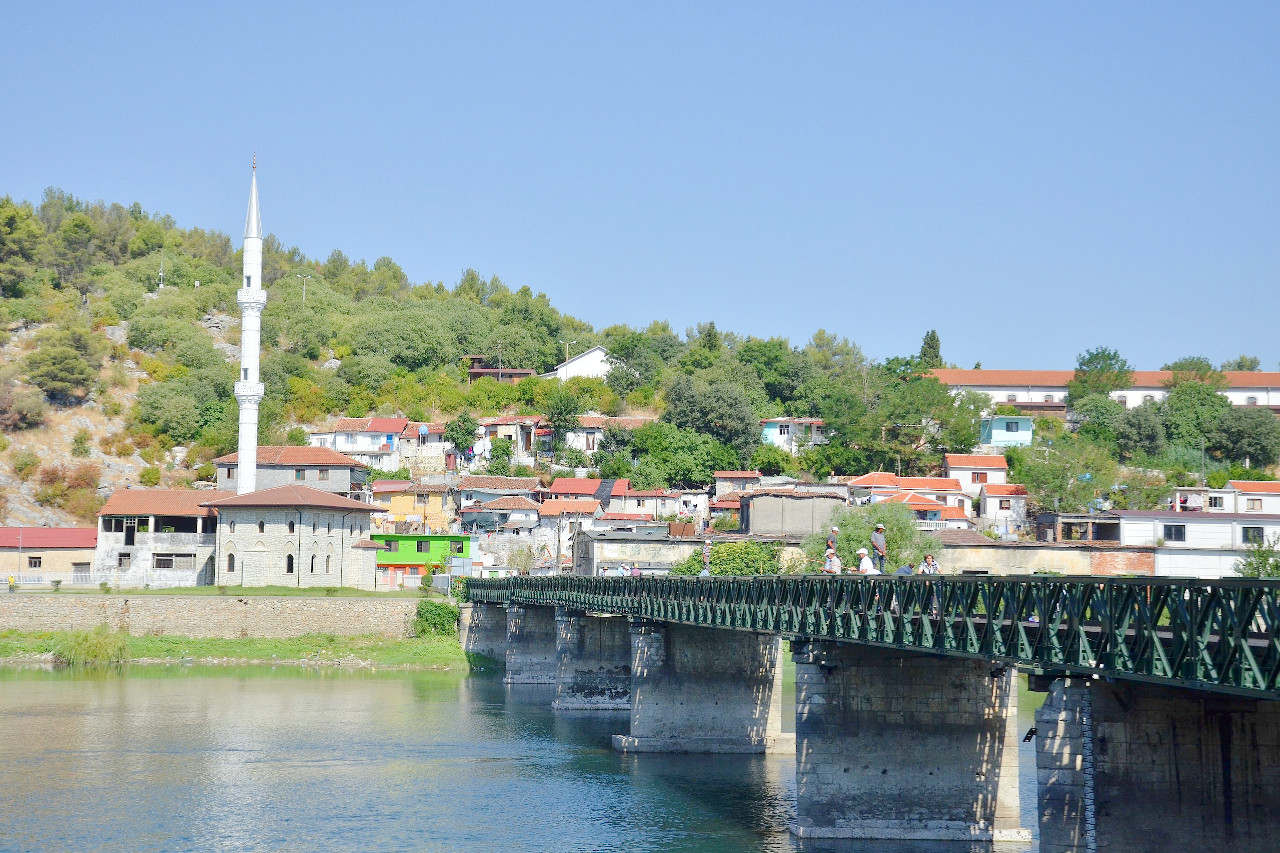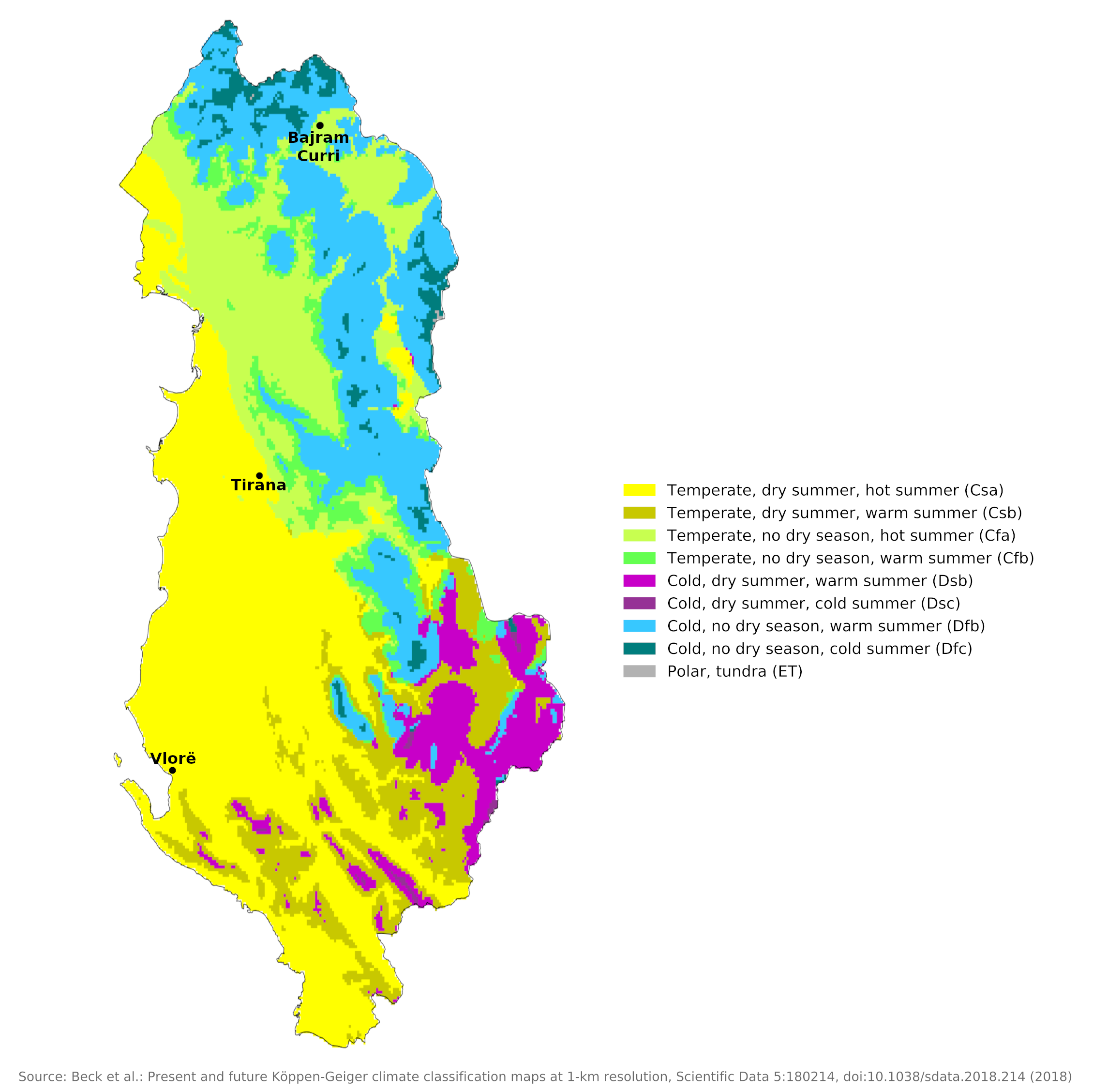The Climate of
Albania
 Old bridge over the Buna river in Shkodër
Old bridge over the Buna river in Shkodër
Climate Map
 Climate map of Albania
Climate map of Albania
What is the climate of Albania like?
Albania is a small, mountainous country. It has a coastline on the Mediterranean and its land frontier with Montenegro, North Macedonia, and Greece traverses some of the wildest mountain scenery in Europe.
Albania has a high number of climatic regions for so small an area. The climate on the coast is typically Mediterranean with mild, wet winters and warm, sunny, and rather dry summers. Inland conditions vary depending on altitude but the higher areas above 1,500 meters (5,000 feet) are rather cold and frequently snowy in winter; here cold conditions with lying snow may linger into spring. For a Mediterranean country the precipitation is rather heavy; coastlands are quite wet in winter and mountain areas are among the wetter parts of Europe. Midsummer months are generally sunny but the fine weather can be interrupted by occasional thundery downpours. The summer temperature in the plains is that of the Mediterranean; in the mountain districts it is high during the day, but falls almost to freezing-point at night.
Average precipitation is heavy: the heaviest rain falling in the central uplands where there are frequent thunderstorms. Lowland rainfall averages from 1,000 millimeters (40 inches) to more than 1,500 millimeters (60 inches) annually, with the higher levels in the north. Most of the rain falls in the winter. Rainfall in the upland mountain ranges is even heavier. Everywhere in Albania, summer and early autumn are the most settled months. Sunshine amounts are quite high, averaging over eleven hours a day in July and four hours a day in January.
The Coast
Summer temperatures are fairly hot on the coast and, although often rather humid, the climate is made more pleasant by the daily sea breezes. Winter conditions on the coast are generally mild but occasional cold winds from the north and east may bring an unwelcome chill for a few days when the mountains inland are covered with snow. The sea-coast is exposed to the fierce bora, or north wind, during the spring. When a warm humid wind—the sirocco—blows from the southwest or south, conditions may feel hot and oppressive. This is particularly the case in autumn when Mediterranean Sea temperatures are at their highest. The sirocco then often precedes wet weather and a return to cooler temperatures. The city of Vlorë is typical of conditions on the coast:
| Climate data for Vlorë | |||||||||||||
|---|---|---|---|---|---|---|---|---|---|---|---|---|---|
| Month | Jan | Feb | Mar | Apr | May | Jun | Jul | Aug | Sep | Oct | Nov | Dec | Year |
| Average high °C (°F) | 13 (55) | 14 (57) | 16 (61) | 19 (66) | 23 (73) | 27 (81) | 30 (86) | 30 (86) | 27 (81) | 23 (73) | 19 (66) | 15 (59) | 21 (70) |
| Daily mean °C (°F) | 10 (50) | 10 (50) | 12 (54) | 15 (59) | 19 (66) | 22 (72) | 25 (77) | 25 (77) | 22 (72) | 19 (66) | 15 (59) | 12 (54) | 17 (63) |
| Average low °C (°F) | 6 (43) | 6 (43) | 8 (46) | 10 (50) | 14 (57) | 17 (63) | 19 (66) | 19 (66) | 16 (61) | 14 (57) | 11 (52) | 8 (46) | 12 (54) |
| Average precipitation mm (inches) | 120 (4.7) | 106 (4.2) | 92 (3.6) | 79 (3.1) | 54 (2.1) | 28 (1.1) | 9 (0.4) | 26 (1.0) | 32 (1.3) | 116 (4.6) | 192 (7.6) | 141 (5.6) | 995 (39.3) |
| Source: Vlore ClimaTemps | |||||||||||||
The Lowlands
The lowlands have mild winters, averaging about 7°C (45°F), (see the climate of Tirana). Summer temperatures average 24°C (75°F), humidity is high, and the weather tends to be oppressively uncomfortable.
| Climate data for Tirana | |||||||||||||
|---|---|---|---|---|---|---|---|---|---|---|---|---|---|
| Month | Jan | Feb | Mar | Apr | May | Jun | Jul | Aug | Sep | Oct | Nov | Dec | Year |
| Average high °C (°F) | 11.6 (52.9) | 12.9 (55.2) | 15.6 (60.1) | 19.0 (66.2) | 23.8 (74.8) | 27.7 (81.9) | 30.7 (87.3) | 30.7 (87.3) | 27.3 (81.1) | 21.8 (71.2) | 17.1 (62.8) | 13.0 (55.4) | 21.0 (69.8) |
| Daily mean °C (°F) | 6.7 (44.1) | 7.8 (46.0) | 10.0 (50.0) | 13.4 (56.1) | 18.0 (64.4) | 21.6 (70.9) | 24.0 (75.2) | 23.8 (74.8) | 20.7 (69.3) | 16.0 (60.8) | 11.7 (53.1) | 8.1 (46.6) | 15.2 (59.4) |
| Average low °C (°F) | 1.8 (35.2) | 2.6 (36.7) | 4.5 (40.1) | 7.9 (46.2) | 12.1 (53.8) | 15.6 (60.1) | 17.2 (63.0) | 16.9 (62.4) | 14.1 (57.4) | 10.1 (50.2) | 6.3 (43.3) | 3.2 (37.8) | 9.4 (48.9) |
| Average precipitation mm (inches) | 143 (5.6) | 132 (5.2) | 115 (4.5) | 104 (4.1) | 103 (4.1) | 68 (2.7) | 42 (1.7) | 46 (1.8) | 78 (3.1) | 114 (4.5) | 172 (6.8) | 148 (5.8) | 1,266 (49.8) |
| Source: Deutscher Wetterdienst | |||||||||||||
The Mountains
In the mountain regions the annual sequence of weather is similar to that in the lowlands but the temperatures are lower. (see the climate for Bajram Curri in the northeastern mountains). Low winter temperatures in the mountains are caused by the continental air mass that dominates the weather in Eastern Europe and the Balkans. Northerly and northeasterly winds blow much of the time. Average summer temperatures are lower than in the coastal areas and much lower at higher elevations, but daily fluctuations are greater. Daytime maximum temperatures in the interior basins and river valleys can be quite high, but the nights are almost always cool. During the stormier conditions of autumn and winter, rain may be heavy and cold and snow severe.
| Climate data for Bajram Curri | |||||||||||||
|---|---|---|---|---|---|---|---|---|---|---|---|---|---|
| Month | Jan | Feb | Mar | Apr | May | Jun | Jul | Aug | Sep | Oct | Nov | Dec | Year |
| Average high °C (°F) | 4.9 (40.8) | 7.5 (45.5) | 12.2 (54.0) | 16.9 (62.4) | 21.9 (71.4) | 25.8 (78.4) | 28.5 (83.3) | 28.5 (83.3) | 24.3 (75.7) | 17.8 (64.0) | 11.2 (52.2) | 6.7 (44.1) | 17.2 (62.9) |
| Daily mean °C (°F) | 1.6 (34.9) | 3.7 (38.7) | 7.6 (45.7) | 11.9 (53.4) | 16.5 (61.7) | 20.3 (68.5) | 22.6 (72.7) | 22.4 (72.3) | 18.5 (65.3) | 13.0 (55.4) | 7.6 (45.7) | 3.5 (38.3) | 12.4 (54.4) |
| Average low °C (°F) | −1.6 (29.1) | −0.1 (31.8) | 3.1 (37.6) | 6.9 (44.4) | 11.1 (52.0) | 14.8 (58.6) | 16.7 (62.1) | 16.4 (61.5) | 12.8 (55.0) | 8.3 (46.9) | 4.1 (39.4) | 0.3 (32.5) | 7.7 (45.9) |
| Average precipitation mm (inches) | 126 (5.0) | 114 (4.5) | 106 (4.2) | 105 (4.1) | 93 (3.7) | 65 (2.6) | 52 (2.0) | 58 (2.3) | 92 (3.6) | 119 (4.7) | 154 (6.1) | 151 (5.9) | 1,235 (48.7) |
| Source: Climate-Data.org | |||||||||||||
References
- E. A. Pearce, Charles Gordon Smith, (1990) The Hutchinson World Weather Guide, John Murray Press. ISBN 1859863426
- Timothy L. Gall, (ed.), (2003), Worldmark Encyclopedia of the Nations, Eleventh Edition, Thomson Gale
- Federal Research Division, Library of Congress, (1994), Albania: a country study. Claitor's Pub. Division. ISBN 0844407925
- Hugh Chisholm, (ed.), (1911), Encyclopædia Britannica, Eleventh edition, Cambridge University Press
The Climate of
Albania

In summary:
Albania has a coastal Mediterranean climate (hot, dry summers and rainy winters) in the western regions and a continental climate (hot summers and cold winters) in the east.
The coastal plain has mild, rainy winters and hot, dry summers. The mountains have warm to hot summers and very cold winters with heavy snowfall; summer rainfall is also heavier in this region than on the coast. Average annual rainfall ranges from about 1000 millimeters (40 inches) on the coastal plain to more than 2500 millimeters (100 inches) in the mountains.